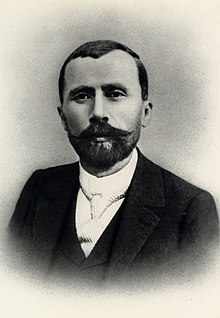Léon Teisserenc de Bort
Léon Teisserenc de Bort | |
|---|---|
 Léon Teisserenc de Bort | |
| Born | Léon Philippe Teisserenc de Bort 5 November 1855 |
| Died | 2 January 1913 (aged 57) |
| Nationality | French |
| Known for | stratosphere |
| Awards | Symons Gold Medal (1908) |
| Scientific career | |
| Fields | Meteorology |
Léon Philippe Teisserenc de Bort (5 November 1855 in
Early life and career
He was the son of an engineer. He began his scientific career in 1880, when he entered the meteorological department of the Bureau Central Météorologique (Administrative Centre of National Meteorology, a department of the French government) in Paris under E. E. N. Mascart. In 1883, 1885 and 1887 he made journeys to North Africa to study geology and terrestrial magnetism, and during this period published some important charts of the distribution of pressure at a height of 4,000 metres. Between 1892 and 1896, Teisserenc de Bort was chief meteorologist to the Bureau.[2]
Instrumented balloons pioneer
After his resignation from the Bureau in 1896, he established a private meteorological observatory in
In 1898, Teisserenc de Bort published an important paper in Comptes Rendus detailing his researches by means of balloons into the constitution of the atmosphere.
Troposphere and stratosphere
During the years that followed, he named the two
Additional investigations
He also carried out investigations near Viborg in
Named after him
See also
References
- ^ [1] Ultraviolet radiation in the solar system By Manuel Vázquez, Arnold Hanslmeier
- ^ a b c d Chisholm, Hugh, ed. (1922). . Encyclopædia Britannica (12th ed.). London & New York: The Encyclopædia Britannica Company.
- ^ "Teisserenc de Bort a life in Meteorology" (PDF). Archived from the original (PDF) on 2009-03-27. Retrieved 2008-08-31.
- ^ Léon Philippe Teisserenc de Bort, Hugo Hildebrand Hildebrandsson, H. Maurice, Ragnar Holm & Martin Jansson, Travaux de la Station Franco-Scandinave de Sondages Aériens à Hald 1902-1903, 1904.
External links
- History of the Teisserenc de Bort observatory (in French)
